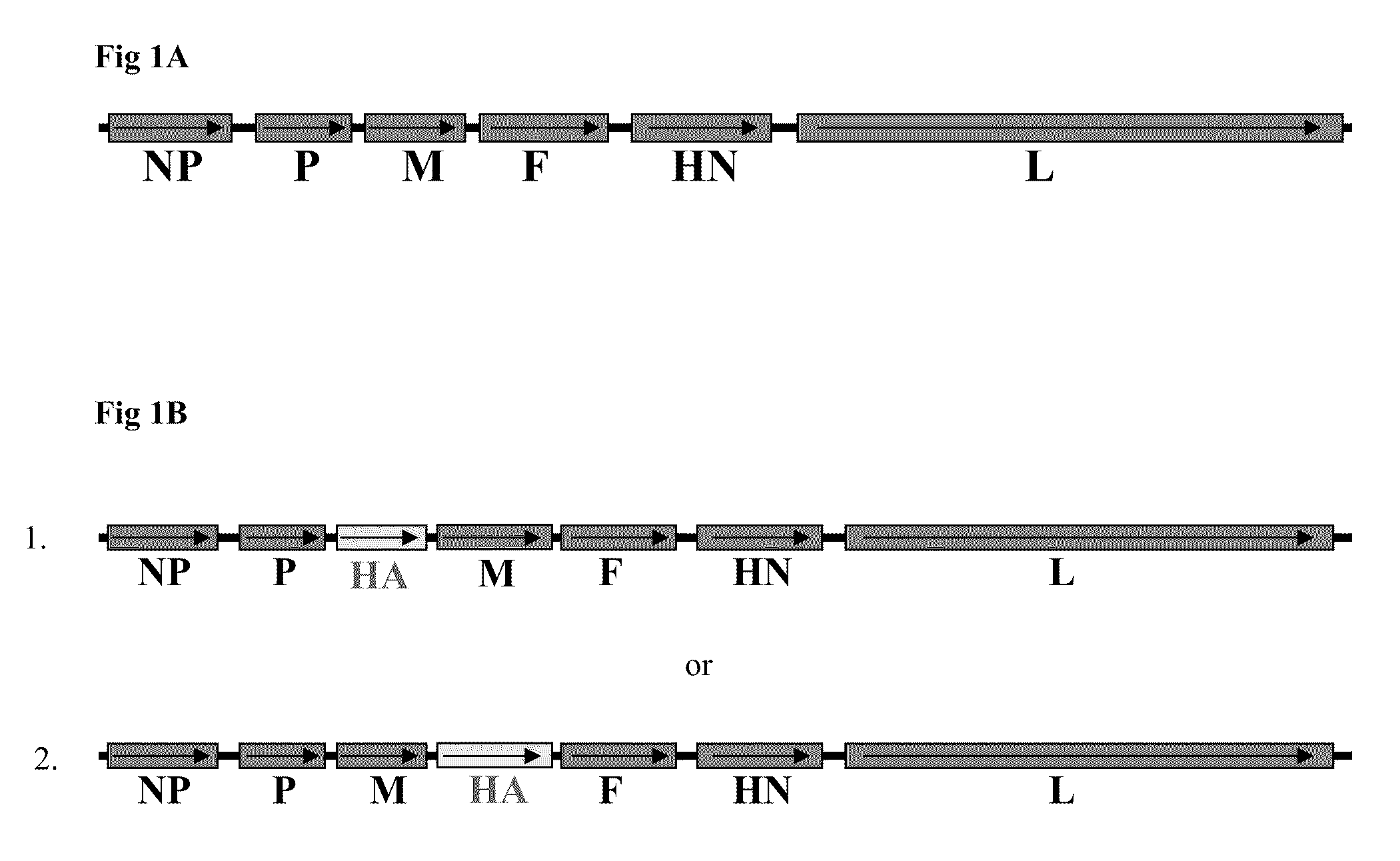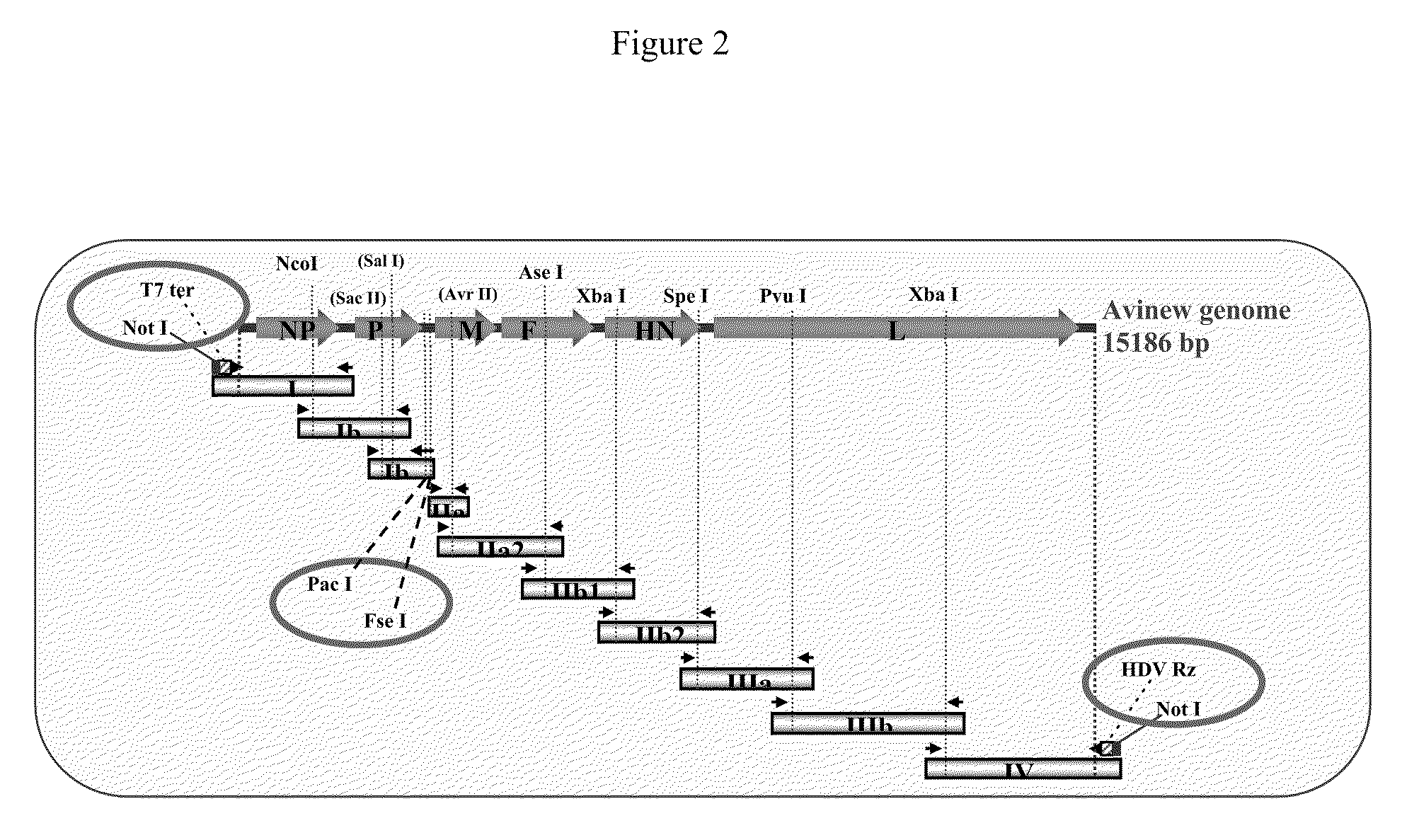Newcastle disease virus vectored avian vaccines
a technology of avian influenza and newcastle disease, which is applied in the field of avian influenza vaccines, can solve the problems of high contagious and fatal disease affecting all species of birds, clinically severe and fatal human infections, and remains a constant major threa
- Summary
- Abstract
- Description
- Claims
- Application Information
AI Technical Summary
Benefits of technology
Problems solved by technology
Method used
Image
Examples
example 1
Development of Reverse Genetics of the AVINEW® (NDV) Strain and Generation of NDV Mutants Expressing Heterologous Genes
[0167]The aim of this Example was to develop the reverse genetics of the AVINEW NDV strain to generate engineered NDV mutants expressing heterologous genes.
[0168]The NDV is a negative RNA virus that contains 6 major genes (NP, P, M, F, HN and L) as depicted in FIG. 1A. The generation of genetically modified NDV virus needs a reverse genetics system. A reverse genetic system has been developed by Applicants based on the AVINEW vaccine strain of NDV. This system permits generation of modified Newcastle Disease Viruses expressing a foreign gene, such as the hemagglutinin (HA) of influenza as depicted in FIG. 1B.
example 1.1
Cloning of the Whole AVINEW NDV Genome into a Transcription Plasmid and Sequence Analysis
[0169]For the purpose of sequencing the genome of AVINEW NDV strain, the whole genome of the AVINEW strain needs to be cloned into a plasmid that is designated as a “transcription plasmid” (see 1. in FIG. 1C). The transcription plasmid allows generating a positive RNA corresponding to the entire genome of the AVINEW strain of NDV. The strategy for AVINEW genome cloning by successively joining a set of 10 overlapping cDNAs fragments amplified from the AVINEW extracted RNA by reverse transcriptase polymerase chain reaction (RT-PCR) is shown in FIG. 2. This final plasmid designated pIV029 (see FIG. 3) contains the complete genome sequence of AVINEW that is under the control of T7 RNA polymerase transcription signals (T7 promoter located upstream) and is terminated by Hepatitis Delta Virus (HDV) ribozyme that is used to cleave the RNA at the authentic NDV genomic terminus followed by T7 terminator. ...
example 1.2
Construction of the Expression Plasmids Containing the NP, P and L Genes of AVINEW NDV
[0172]In the reverse genetics system, plasmids designated “expression plasmids” that encode the nucleocapsid (NP), phosphoprotein (P) and large polymerase protein (L) under the control of the T7 RNA polymerase promoter need to be constructed (see FIG. 1C). These three proteins are associated with viral RNA to form the RiboNucleoProteins (RNPs) which represent the smallest infectious unit of NDV. The complex composed of NP, P, and L proteins presents RNA dependent RNA polymerase activity.
[0173]The expression plasmids pIV32 (FIG. 5), pIV33 (FIG. 6) and pIV34 (FIG. 7) were constructed and contain the NP, P and L genes of AVINEW, respectively, under the control of the T7 RNA polymerase promoter and Foot and Mouth Disease Virus (FMDV) Internal Ribosome Entry Site (IRES).
PUM
| Property | Measurement | Unit |
|---|---|---|
| Fraction | aaaaa | aaaaa |
| Fraction | aaaaa | aaaaa |
| Volume | aaaaa | aaaaa |
Abstract
Description
Claims
Application Information
 Login to View More
Login to View More - R&D
- Intellectual Property
- Life Sciences
- Materials
- Tech Scout
- Unparalleled Data Quality
- Higher Quality Content
- 60% Fewer Hallucinations
Browse by: Latest US Patents, China's latest patents, Technical Efficacy Thesaurus, Application Domain, Technology Topic, Popular Technical Reports.
© 2025 PatSnap. All rights reserved.Legal|Privacy policy|Modern Slavery Act Transparency Statement|Sitemap|About US| Contact US: help@patsnap.com



